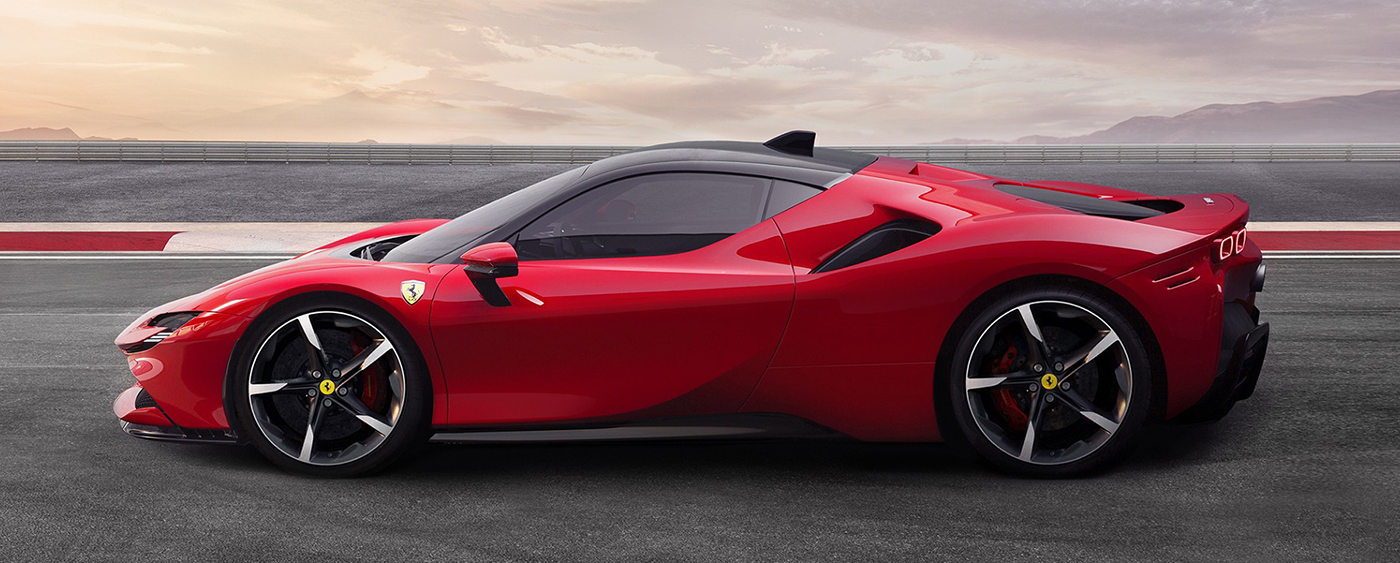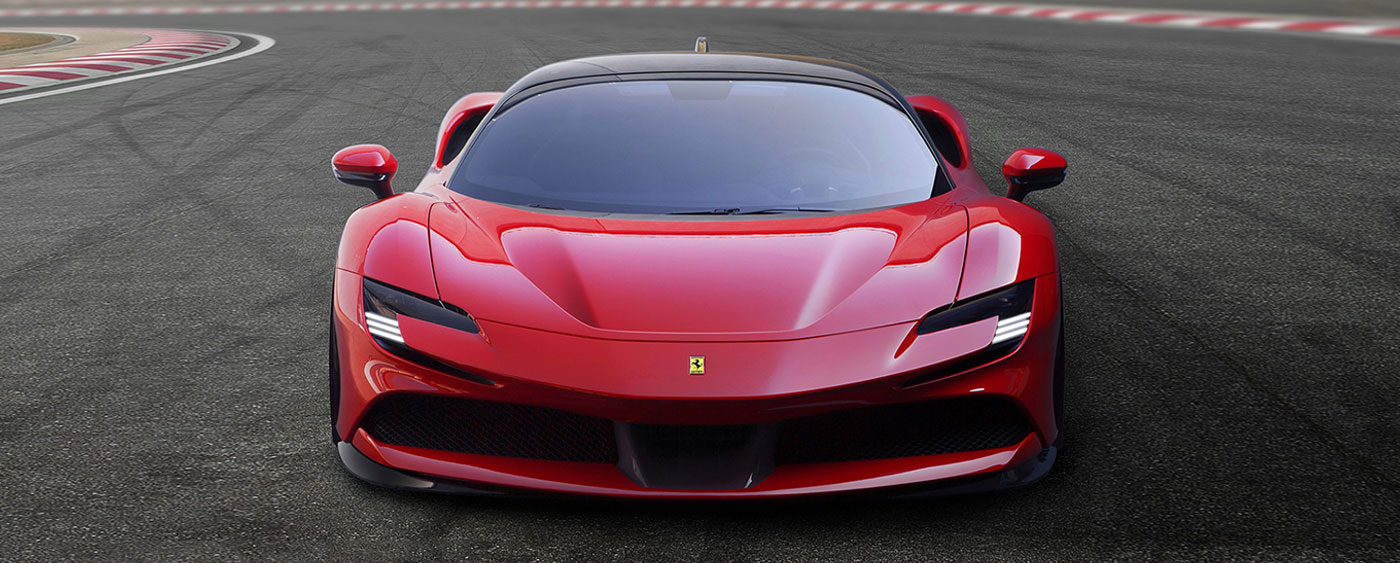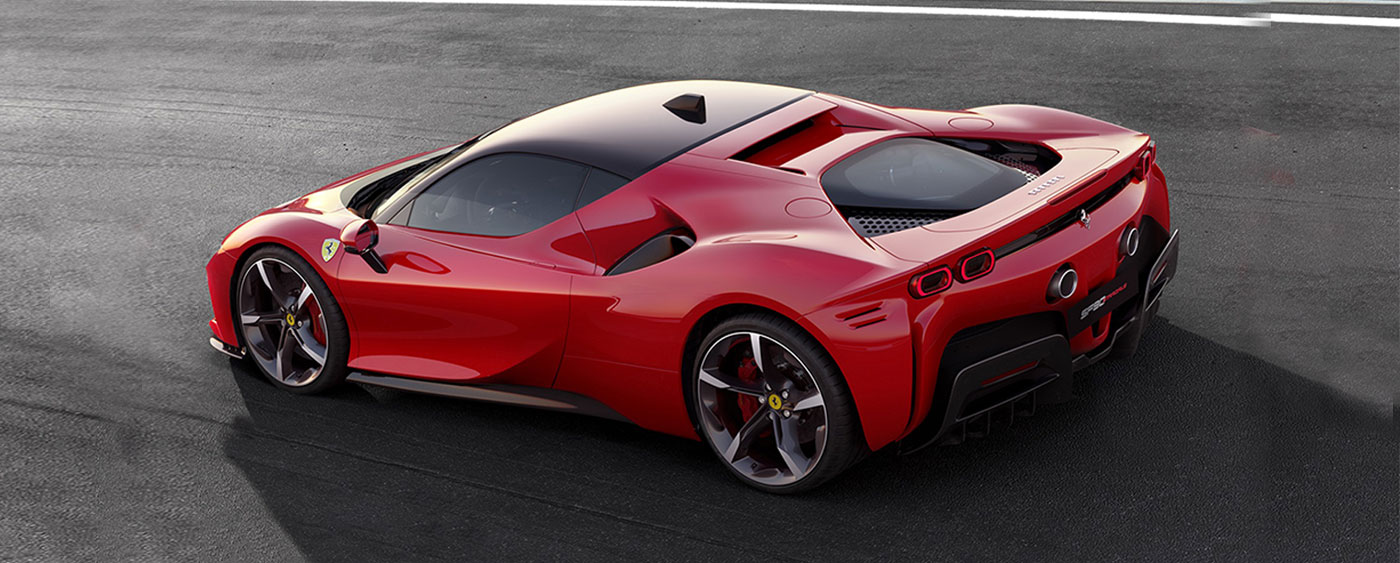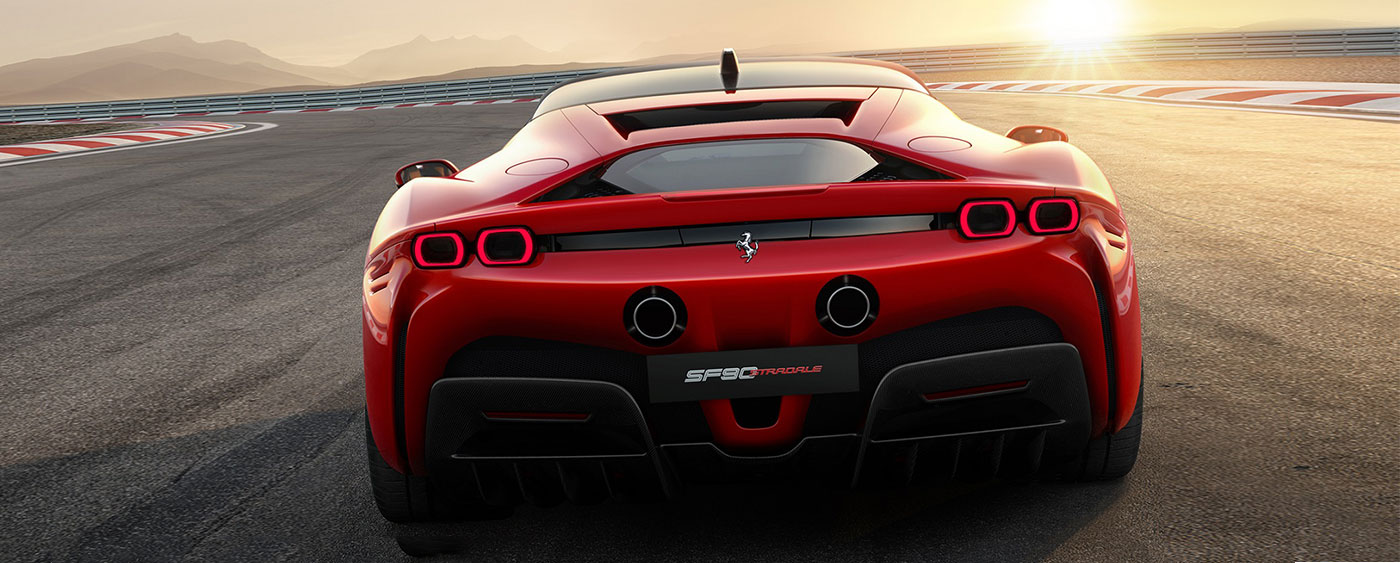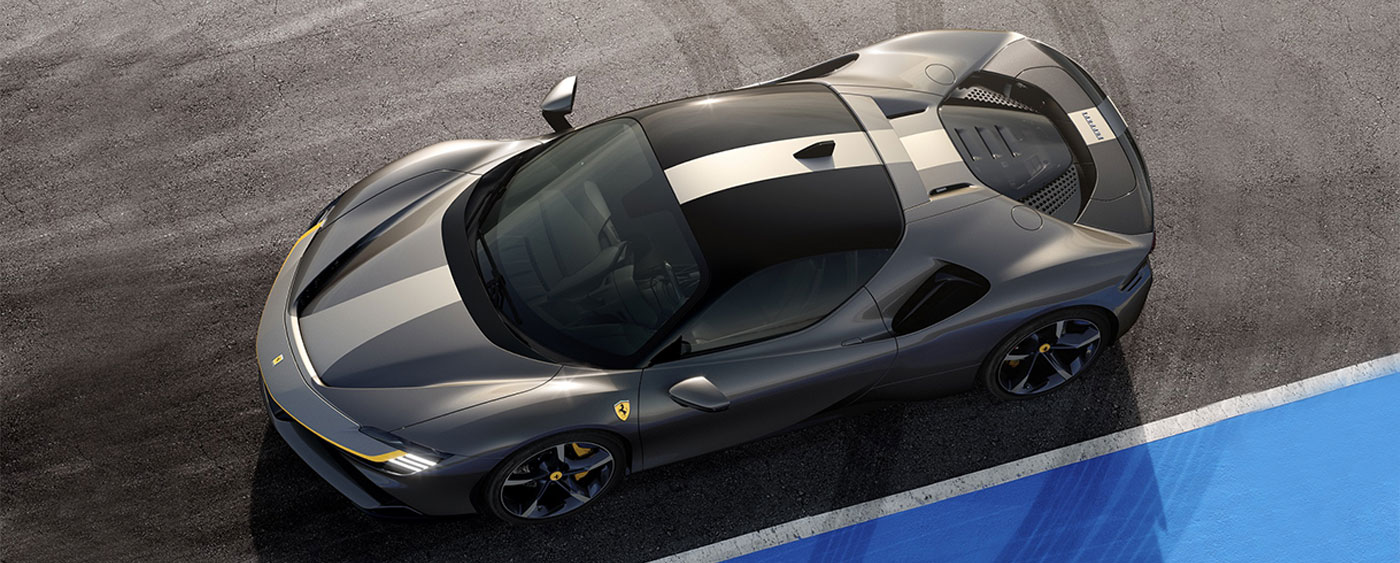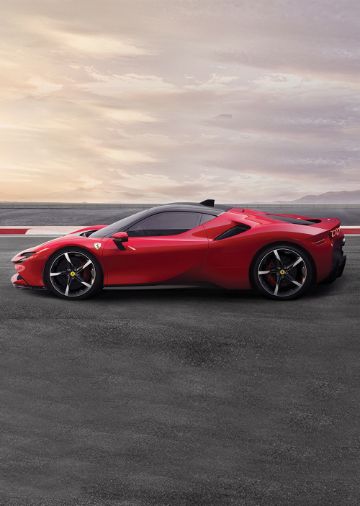
The Ferrari SF90 Stradale is not only the most powerful hypercar in the Italian luxury automaker’s stable, but it’s also a plug-in hybrid where a V8 engine teams up with three electric motors, for a heartpounding ride.
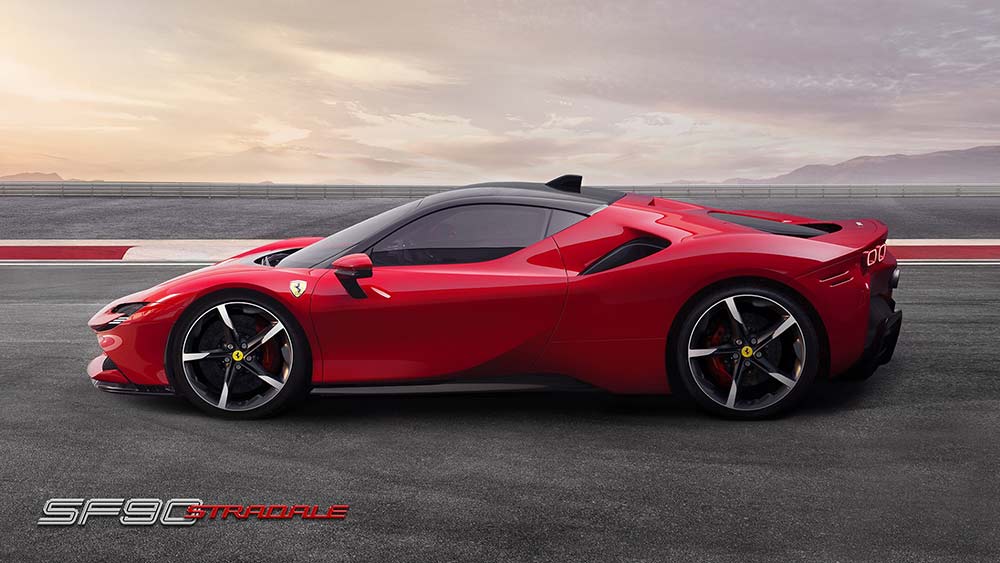
Ferrari has rolled out what is probably its most powerful hypercar yet. But it’s the fact that the new SF90 Stradale (named after the 90th anniversary of the foundation of Scuderia Ferrari) is a plug in hybrid – a 90° V8 turbo engine capable of delivering 780 cv, the highest power output of any 8-cylinder in Ferrari history, with the remaining 220 cv delivered by three electric motors, one at the rear – that is the veritable tour de force.
A brilliant encapsulation of the most advanced technologies developed in Maranello, the SF90 Stradale is the perfect demonstration of how Ferrari immediately transitions the knowledge and skills it acquires in competition to its production cars. Not only is it a PHEV (Plug-in Hybrid Electric Vehicle), the SF90 Stradale has a new 8-speed dual-clutch transmission on the rear axle, and two on the front axle. But with all its sophisticated technology, the driving experience is far from complicated. The driver simply has to select one of the four power unit modes, and then just concentrate on driving. The sophisticated control logic takes care of the rest, managing the flow of power between the V8, the electric motors and the batteries.
The SF90 Stradale is also the first Ferrari sports car to be equipped with 4WD, a step necessary to allow the incredible power unleashed by the hybrid powertrain to be fully exploited, ensuring the car has become the new benchmark for standing starts: 0-100km/h in 2.5 sec and 0-200km/h in barely 6.7 seconds.
Ferrari’s engineers were able to further broaden the spectrum of dynamic controls by introducing the full-electric front axle, known as the RAC-e (electronic cornering set-up regulator). As well as exclusively providing propulsion in electric drive, the two front motors independently control the torque delivered to the two wheels, extending the concept of Torque Vectoring. Fully integrated into the car’s vehicle dynamics controls, the RAC-e governs the distribution of torque, making driving on the limit much simpler and easier.
The introduction of this hybrid architecture was a challenge with regard to managing the additional weight which was resolved by an obsessive attention to detail and the overall optimisation of the whole of the car. For maximum performance in terms of overall weight, rigidity and centre of gravity, the chassis and bodyshell of the SF90 Stradale is all new, built using multi-material technology, including, for example, carbon fibre.
The development of a hybrid car of this kind demanded the development of a series of innovative aerodynamic solutions. The significant boost in the power unit’s performance brought with it an increase in the amount of heat energy to be dissipated and required the development team to carry out an in-depth review of the aerodynamic flows on the radiating masses. It also demanded new solutions to increase downforce efficiently and guarantee maximum stability at all speeds and in all driving conditions.
Particularly noteworthy is the innovative shut-off Gurney, a patented active system located at the rear of the car which regulates the air flow over the upper body, reducing drag at high speeds with low lateral dynamics loads and increasing downforce in corners, under braking and during changes of direction.
The new car is epoch-changing from a stylistic perspective as it completely rewrites the mid-rear-engined sports berlinetta proportions introduced on the 360 Modena twenty years ago, instead taking its inspiration from Ferrari’s recent supercars. A good example is the cockpit, which has a smaller frontal section and is placed closer to the front of the car to reduce drag. This was also achieved without impacting on-board comfort.
The track-derived “eyes on the road, hands on the wheel” philosophy takes on a truly central role for the first time too, significantly influencing the ergonomics and styling of the interior. The result is an HMI (Human-Machine Interface) and interior layout concept that are a complete departure from previous models.
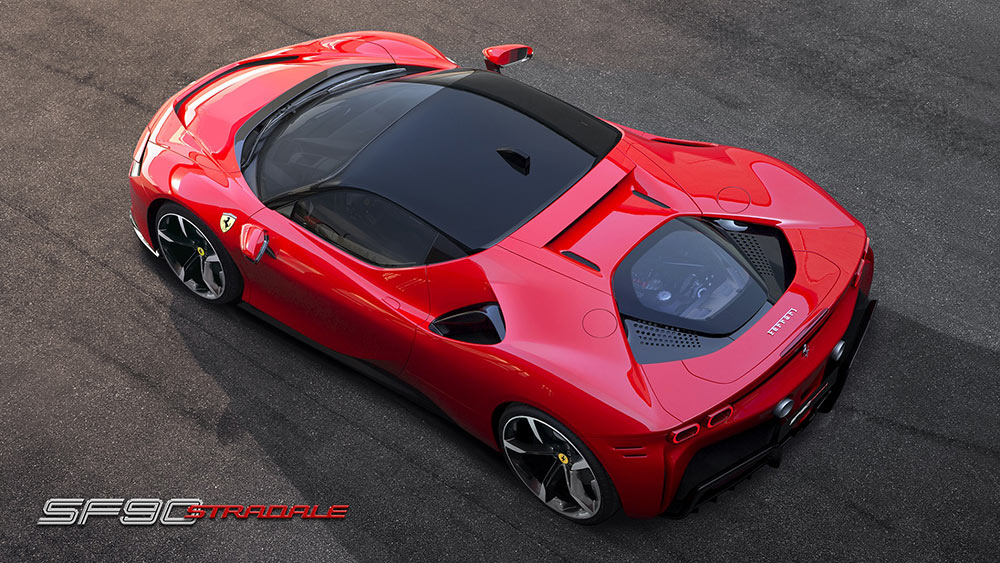
Another major innovation is the steering wheel which now has a touchpad and a series of haptic buttons that allow the driver to control virtually every aspect of the car using just their thumbs. The central instrument cluster is now entirely digital with the first automotive application of a 16” curved HD screen which can be fully configured and controlled using the controls on the steering wheel.
On the central tunnel, improved ergonomics have been combined with an element from the past: the automatic gearbox controls are now selected by a grille-style feature that references Ferrari’s legendary manual gear-shift gate. Thus past and present skilfully merge to point the new Ferrari towards the future.
The SF90 Stradale also sees the debut of the new ignition key with full keyless technology which will gradually be introduced across the rest of the range, personalised with the model’s name. Thanks to a special compartment in the central tunnel, it becomes an integral part of the car’s styling.
In addition to the sporty version, which references the shape and colour of the signature rectangular Prancing badge sported by Ferrari’s road cars, there will also be a more elegant metal-coloured version.
For the first time on a Ferrari, clients can chose between the standard car and a version with a more sports-oriented specification. The Assetto Fiorano specification includes significant upgrades, including special GT racing-derived Multimatic shock absorbers, extra lightweight features made from high-performance materials such as carbon-fibre (door panels, underbody) and titanium (springs, entire exhaust line), resulting in a weight-saving of 30 kg. Another difference is the high downforce carbon-fibre rear spoiler which generates 390 kg of downforce at 250 km/h. The Assetto Fiorano includes Michelin Pilot Sport Cup2 tyres designed specifically to improve performance on the track in the dry. They feature a softer compound and fewer grooves than the tyres provided as standard.
INTERNAL COMBUSTION ENGINE
Thanks to its 780-cv power output, the turbo V8 featured in the SF90 Stradale raises the bar for the performance limits achievable by this type of architecture. The starting point was the F154 family engine which has won the International Engine of the Year award for the fourth consecutive year, an unprecedented achievement for any power unit.
Together with its 195 cv/l specific power output, which is the highest in the segment, the engine also delivers 800 Nm of torque at 6,000 rpm. To deliver this extraordinary result, Ferrari’s engineers focused on several different areas of the engine, starting by increasing its capacity from 3,902 cc to 3,990 cc thanks to a larger bore of 88 mm.
The intake and exhaust system was completely redesigned and now features a new, narrower cylinder head with a central injector and the adoption of 350-bar GDI, another first for a Ferrari V8.
To improve the internal fluid dynamics, not only was a larger diameter intake valve adopted but the ducts are all horizontally lined up at engine head height; the turbo charger assembly has been lowered while the exhaust line is higher, as testified by the fact that the tail pipes are now in the upper section of the rear bumper. The turbos are now equipped with electronically-controlled wastegates to improve catalyser heating and new compressor volutes to optimise fluid-dynamics.
The re-engineering goes well beyond fluid-dynamics: the rationalisation of the layout has resulted in both a lower centre of gravity, thanks in part to the adoption of a smaller-diameter fly wheel, and a reduction in overall weight thanks to the use of Inconel instead of steel for the exhaust manifold. Meticulous attention was lavished on sound quality when redesigning the exhaust system and the result is fuller, richer harmonics across the entire frequency range.
GEARBOX
The SF90 Stradale sports a completely redesigned 8-speed, oil-bath, dual-clutch transmission. New gear ratios and improved transmission efficiency yield a significant reduction in fuel consumption in urban and motorway driving (-8% in the WLTP cycle) without having to compromise on performance. In fact, there is even a 1% improvement in efficiency on the track.
An optimised layout, achieved through the adoption of a dry sump and a significantly more compact clutch assembly with a 20% smaller exterior diameter than the current gearbox, has shaved 15 mm off the installed height in the car which, in turn, lowers the centre of gravity of the running gear by the same amount.
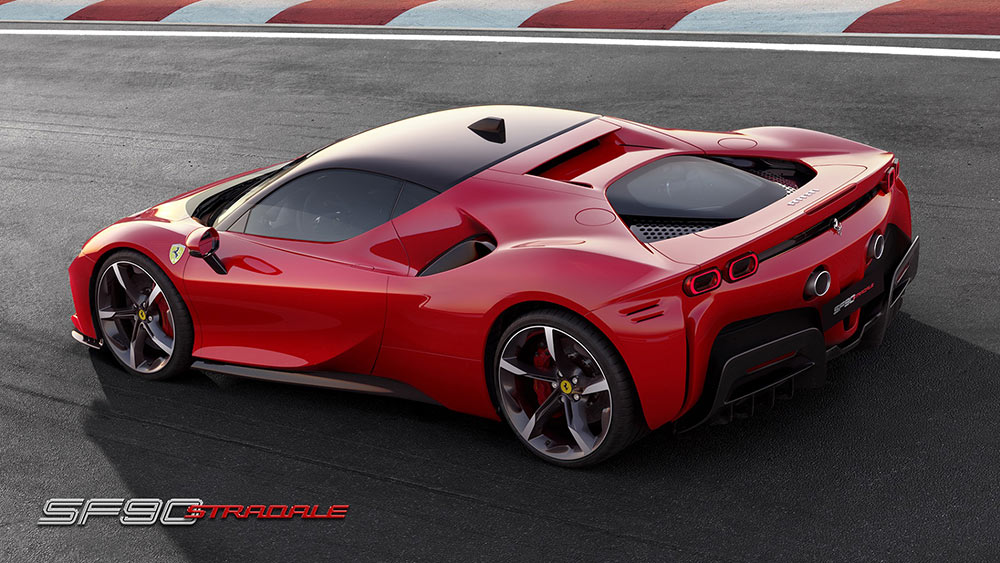
Despite the addition of an eighth gear and a maximum torque boost to 900 Nm (the latter an increase of 20% on the current 7-speed), the gearbox’s overall weight is actually 7 kg lower. That figure rises to 10 kg when the elimination of the reverse gear – now incorporated in the function of the front electric motors - wheels is included.
The new clutch’s performance is 35% higher, transmitting up to 1200 Nm in dynamic torque in gear shifts. Thanks to new-generation actuation hydraulics, total clutch fill times have been cut to 200 ms compared to the 488 Pista’s 300 ms.
ELECTRIC MOTORS
The SF90 Stradale is equipped with three electric motors capable of generating a total of 220 cv (162 kW). A high performance Li-ion battery provides power to all three motors and guarantees a 25-kilometre range in all-electric eDrive mode, using just the front axle. When the internal combustion engine is turned off, the two independent front motors deliver a maximum speed of 135 km/h with longitudinal acceleration of ≤0.4 g. Reverse can only be used in eDrive mode which means the car can be manoeuvred at low speeds without using the V8. The front motors are integrated into the launch control strategy for maximum performance when accelerating.
Ferrari’s engineers chose to put the battery pack immediately behind the seats, just above the chassis rear cross member, rather than going for the classic layout in which the batteries would be sunken into the floor pan. This guaranteed the best possible packaging, with a short wheelbase for handling and lower weight, limiting the impact on the centre of gravity.
FUNCTION MODES
The internal combustion engine and electric motors work in synergy to generate an incredible 1,000 cv, which puts the SF90 Stradale at the very top of the range in performance terms. The control logic optimally manages the power flows either with the emphasis on efficiency or performance depending on the user profile selected by the driver.
Thanks to an additional steering wheel-mounted selector, dubbed the eManettino (analogous to the Manettino which is used to set the electronic vehicle dynamics modes), the driver can choose from four different power unit management modes:
eDrive: the internal combustion engine remains off and traction is entrusted entirely to the electric front axle. Starting with a fully charged battery, the car can cover up to 25 km in this mode.. This mode is ideal for city centre driving or any other situation in which the driver wishes to eliminate the sound of the Ferrari V8.
Hybrid: this is the default setting when the car is turned on, in which the power flows are managed to optimise the overall efficiency of the system. The control logic autonomously decides whether to keep the internal combustion engine running or turn it off. If it is on, the internal combustion engine can run at maximum power thus guaranteeing powerful performance whenever the driver requires.
Performance: unlike ‘Hybrid’, this mode keeps the ICE running because the priority is more on charging the battery than on efficiency. This guarantees that power is instantly and fully available when required. This mode is best suited to situations in which driving pleasure and fun behind the wheel are the main focus.
Qualify: this mode allows the system to achieve maximum power output by allowing the electric motors to work at their maximum potential (162kW). The control logic prioritises performance over battery charging.
VEHICLE DYNAMICS
The exceptional work done to boost the power unit’s power would have all been in vain without in-depth dynamics research and the development of a whole series of solutions to boost the SF90 Stradale’s lap times, whilst simultaneously guaranteeing that drivers of all kinds could make full use of the car’s potential and have fun behind the wheel.
The new hybrid architecture required extensive and lengthy integration work on the car’s many different control logics. The three areas concerned are: the high-voltage system controls (battery, RAC-e, MGUK, inverter), engine and gearbox control and vehicle dynamics controls (traction, braking, Torque Vectoring).
Integrating these areas with the existing vehicle control logics led to the development of the new eSSC (electronic Side Slip Control) vehicle control system. The eSSC introduces three innovative dynamic regulation and distribution strategies for engine torque to all four wheels:
- Electric Traction Control (eTC): optimally manages the availability of the torque – both ICE and electric - distributing it to the individual wheels to suit driving conditions and grip requirements
- brake-by-wire control with ABS/EBD: allows the braking torque to be split between the hydraulic system and the electric motors (brake torque blending), allowing regenerative recovery under braking which actually boosts performance and brake feel rather than compromising them
- Torque Vectoring: available on the front axle to manage electric traction on outside and inside wheel in cornering to maximise traction exiting the corner and help ensure easy, confident, high-performance driving.
LONGITUDINAL DYNAMICS
Thanks to the introduction of the RAC-e electric axle and traction control, eTC (Electronic Traction Control), on all four wheels, it is now possible to exploit the additional grip offered by the front wheels when accelerating. Improved overall grip combined with the improved power delivery from the electric motors at low speeds, has significantly improved the SF90 Stradale’s longitudinal acceleration, making it the new benchmark for standing starts.
Even at high speeds and in higher gears, the combined contribution of the electric motors in maximum traction conditions helps reduce ICE response times, significantly improving longitudinal acceleration and thus performance.
The new brake-by-wire system manages kinetic energy recovery through the electric motors by implementing electronically-controlled blending of hydraulic and electric braking, entirely unnoticed by the driver. Under normal braking conditions, energy recovery using the electric motors is the priority. The hydraulic system intervenes to support the electric one under hard braking.
LATERAL DYNAMICS
The eSSC control logic also supervises how torque is distributed between the front wheels using the RAC-e motors and the electronic control derived from the Torque Vectoring concept, varying between the inside and the outside wheel in cornering based on dynamic conditions with the aim of maximising performance and delivering easier handling.
CHASSIS
Although the extra 270 kg required to incorporate the hybrid system into the car have been amply offset by the extra power delivery (220 cv, with a weight/power ratio for the system alone of 1.23 kg/cv), in-depth research was still required to ensure that overall weight was kept to 1,570 kg, thus guaranteeing a record-breaking weight/power ratio of 1.57 kg/cv.
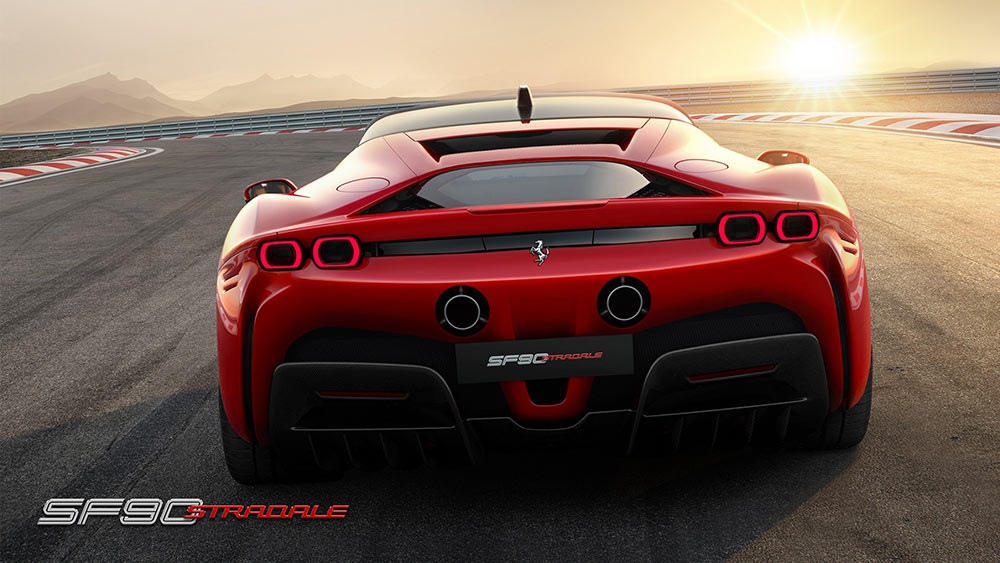
The chassis has been completely redesigned with a multi-material and multi-technology approach to absorb the extra stresses associated with the new power unit and the introduction of AWD. A number of technological innovations have been introduced, not least hollow castings, which replace the traditional ribbed castings. Other new solutions include an all-carbon-fibre bulkhead between the cabin and the engine and two new aluminium alloys, one of which is a high-strength 7000 series alloy for some of the sheet metal. As a result, the SF90 Stradale chassis boasts 20% higher bending stiffness and 40% higher torsional rigidity than previous platforms without any increase in weight. This has significant advantages for the car’s dynamics. NVH (noise, vibration, harshness) characteristics have also been improved by the use of a new alloy known as ‘quiet aluminium’ for the floor pan.
AERODYNAMICS
The greatest challenge in crafting the aerodynamics of the SF90 Stradale was posed by the need to deliver downforce and aerodynamic efficiency at a level never before achieved either by Ferrari or its competitors, whilst simultaneously guaranteeing that all the subsystems of the new power unit (internal combustion engine, electric motors, battery and inverters) would always function as optimally as possible.
As always, the aerodynamics department worked closely with Ferrari Design and this produced downforce and efficiency figures unmatched by any other car in the segment. Once again, they were achieved in typical Ferrari fashion: rather than using simple add-on elements, the car’s forms were meticulously sculpted.
The results in terms of performance are impressive indeed: thanks to its ability to generate 390kg of downforce at 250 km/h, the SF90 Stradale is now the new benchmark for downforce and efficiency in high-performance road cars.
DESIGN
The SF90 Stradale is the most advanced car in the range from a point of view of performance and technology. The definition of the exterior styling was inspired by that principle: to create a forward-looking, innovative design that transmits the car’s mission as an extreme sports car – Ferrari’s first series production supercar.
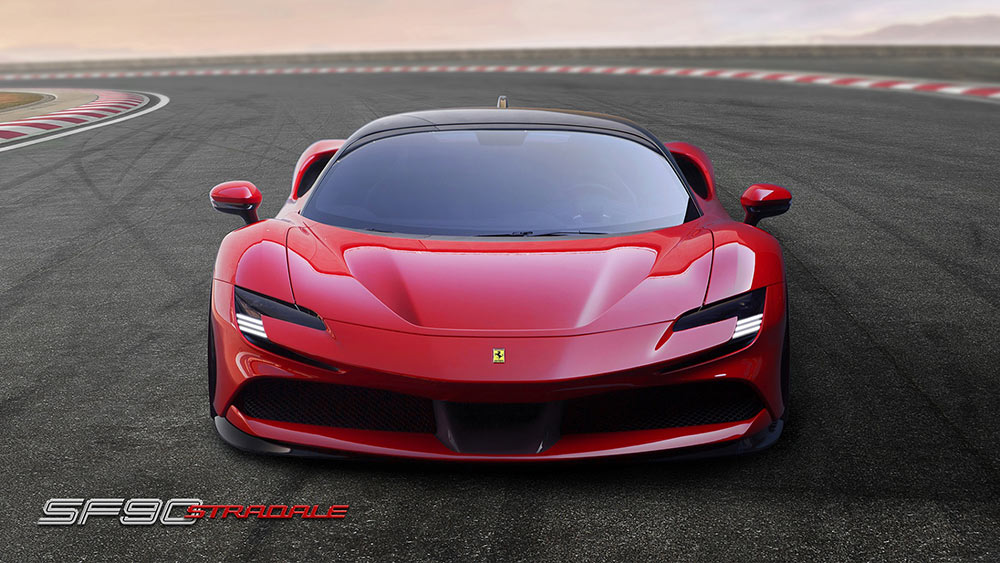
Ferrari Design has thus completely revisited the proportions of the front, central and rear volumes in a radical evolution of the forms of Ferrari’s mid-rear-engined production berlinettas of the last twenty years.
The aim was to design a leading-edge extreme car capable of delivering completely unprecedented performance for a Prancing Horse production car. The SF90 Stradale slots in between the mid-rear-engined coupés, today represented by the F8 Tributo, and supercars of the likes of LaFerrari, and is the new standard-bearer for hyper-technological extreme cars brimming with future-forward content.
Exterior
The SF90 Stradale’s architecture, in which the cabin is located ahead of the mid-mounted engine, provided Flavio Manzoni and his team of designers at the Ferrari Styling Centre, with the ideal platform on which to craft a genuine supercar of impeccable proportions.
More compact overhangs (the rear one is shorter than the front one in particular) and the frontward-shift of the cabin have created a cab-forward-type architecture which emphasises the fact that the engine is mid-mounted. A very low centre of gravity has also allowed the designers to lower the cabin area by 20 mm. Combined with a more curved windshield, slender A-posts and a wide track, this creates a beautifully proportioned car with sleeker volumes.
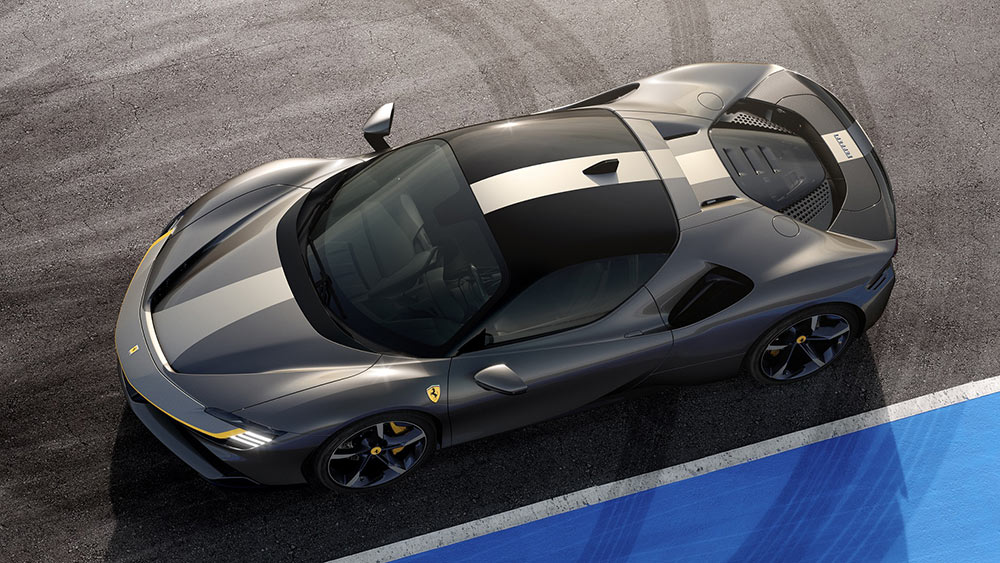
The compact bubble-shaped cabin has an aeronautical cockpit feel and the fact that it has been shifted so far forward is further emphasised by the geometry of the two body-coloured rear flying buttresses that enclose the rear.
Another signature solution is the headlights which hail a move away from the L-shaped look, to a slender slit design integrated with the brake air intakes resulting in a characteristic C-shape which lends the front of the car an original and futuristic appeal. In an absolute first for a Ferrari, the SF90 Stradale uses matrix LED headlight technology to improve visibility in all driving conditions thanks to active beam control.
The rear of the car is dominated by high exhaust pipes which are the result of optimization of the exhaust line layout. Because the power- train is significantly lower in the car than in the past, the designers were also able to lower the car’s tail. Another deviation from the styling typical of past berlinettas is the way the profile of the rear screen no longer follows the line from the roof to the rear bumper. This element of styling discontinuity is evidenced by the separation of the screen from the cooling grille.
The tail lights have also evolved quite radically from Ferrari’s iconic round shape. The eye-catching, more horizontal luminous rings create a more horizontal perception of the tail lights which in turn visually lowers the height of the tail.
Interior
While the SF90 Stradale’s exterior was crafted to underscore its seamless combining of form, technology and performance, the interior is even more radical. The very explicit aim there was to create a cockpit that ushered in an entirely new design direction, the effects of which would carry over into Ferrari’s entire future range.
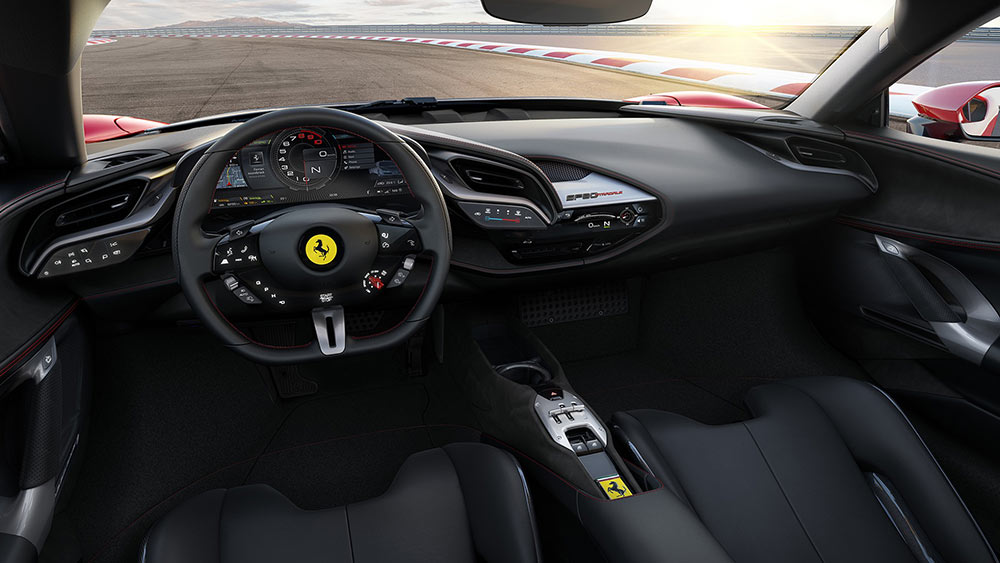
The designers took a futuristic approach to the interface concept with a strong focus on creating a wraparound aeronautically-inspired cockpit with particular emphasis on instruments. This further emphasised and underscored the symbiotic relationship between car and driver. In fact, the SF90 Stradale makes an epoch-changing leap forward both in formal and content terms, updating the Human Machine Interface with all-digital technology.
In a first for a Ferrari, the central instrument cluster comprises a single 16” digital HD screen which curves towards the driver to make it easier to read and to emphasise the F1-style wrap-around cockpit effect. This is the first time this type of screen has been adopted in a production car.
When the engine and motors are off, the onboard instruments go black lending the cockpit a wonderfully sleek, minimalist look. In line with Ferrari tradition, the default screen is dominated by a large circular rev counter which, however, this time is framed by the battery charge indicator. The navigation screen is on one side of the rev counter with the audio control one on the other.
The “hands-on-the-wheel” philosophy has consistently driven the development of the human-machine interface in every Ferrari F1 car and its subsequent gradual transfer to its road-going sports cars. The SF90 Stradale’s steering wheel completes that transfer process from the competition world and also ushers in a new era by introducing a series of touch commands that allow the driver to control virtually every aspect of the car without ever taking their hands off the wheel.
The traditional controls include the now-classic steering-wheel mounted headlight control, windscreen wipers, indicators and the Manettino for driving modes.
Of the new touch controls, the compact but functional pad on the right-hand spoke allows the driver to navigate the central cluster screens, while voice and cruise controls are on the left-hand spoke. Also noteworthy is the adoption of a rotary switch for cruise control, a solution derived directly from the Formula 1 car. In the bottom left section of the central area, there are four buttons the driver uses to select the power unit use mode. 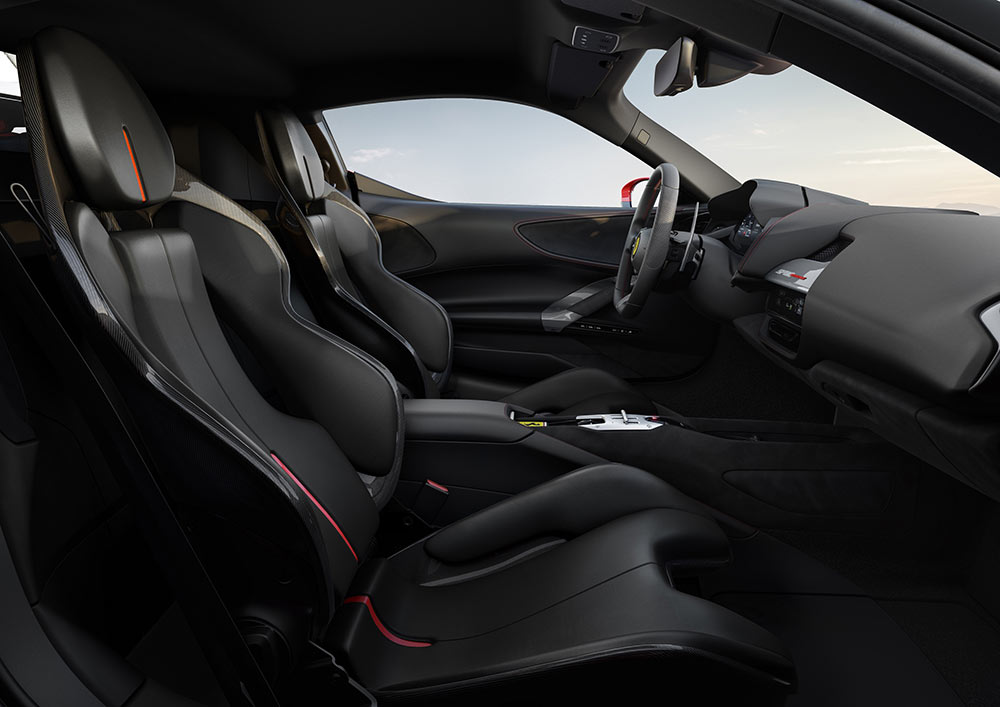
The Head Up Display is another part of the innovative HMI and allows various data to be projected onto the windshield within the driver’s field of vision so that their attention is not distracted from driving.
From a creative perspective, the SF90 Stradale interface project gave the Ferrari Style Centre’s designers the opportunity to interpret the screens in the cabin as a canvas on which all the car’s functions and controls could be represented. The screen graphics on the SF90 Stradale were also designed to create a 3D effect which is particularly striking during transitions, such as when the instrument panel is turned on or when swapping from one screen to the next.
Alongside the new-concept HMI, another major theme tackled in the cabin was the tunnel area interface. The F1 controls on the “bridge” are probably the most iconic of the Ferraris of recent generations. These have been completely redesigned and set into a modern metal plate which references an equally iconic feature from the past: the classic gear lever gate.
7 YEARS MAINTENANCE
Ferrari’s unparalleled quality standards and increasing focus on client service underpin the extended seven-year maintenance programme offered with the SF90 Stradale. Available across the entire Ferrari range, the programme covers all regular maintenance for the first seven years of the car’s life. This scheduled maintenance is an exclusive service that allows clients the certainty that their car is being kept at peak performance and safety over the years. This very special service is also available to owners buying pre-owned Ferraris.
Regular maintenance (at intervals of either 20,000 km or once a year with no mileage restrictions), original spares and meticulous checks by staff trained directly at the Ferrari Training Centre in Maranello using the most modern diagnostic tools are just some of the advantages of the Genuine Maintenance Programme.
The service is available on all markets worldwide and from all Dealerships in the Official Dealership Network.
TECHNICAL SPECIFICATIONS
| Internal combustion engine | |
| Type | V8 - 90° - turbo – dry sump |
| Total displacement | 3990 cc |
| Maximum power output* | 574 kW (780 cv) @ 7500 rpm |
| Max torque | 800 Nm @ 6000 rpm |
| Specific power output | 195 cv/l |
| Max. engine speed | 8000 rpm |
| Compression ratio | 9.5:1 |
| Hybrid system | |
| Maximum power electric motors | 162 kW (220 cv) |
| Battery capacity | 7.9 kWh |
| Max. range under electric power | 25 km |
| Dimensions and weight | |
| Max. range under electric power | 25 km |
| Length | 4710 mm |
| Width | 1972 mm |
| Height | 1186 mm |
| Wheelbase | 2650 mm |
| Front track | 1679 mm |
| Rear track | 1652 mm |
| Dry weight** | 1570 kg |
| Weight distribution | 45% front - 55% rear |
| Boot capacity | 74 l |
| Rear shelf capacity | 20 l |
| Fuel tank capacity | 68 l (2 reserve) |
| Tyres | |
| Front | 255/35 ZR 20 J9.5 |
| Rear | 315/30 ZR 20 J11.5 |
| Brakes | |
| Front | 398 x 223 x 38 mm |
| Rear | 360 x 233 x 32 mm |
| Transmission and gearbox | 8-speed, F1 dual-clutch transmission |
| Electronic controls | E-Diff3, F1-Trac, high performance ABS/EBD with Ferrari Pre-Fill, FrS SCM-E, FDE+, SSC 6.1 |
| Performance | |
| Maximum speed | >340 km/h |
| 0-100 km/h | 2.5 s |
| 0-200 km/h | 6.7 s |
| 100-0 km/h | 29.5 m |
| Dry weight/power | 1.57 kg/cv |
| Laptime at Fiorano | 79s |
| Fuel consumption and emissions | |
| Under homologation | |
| * With 98 octane petrol | |
| ** With optional extras | |
FOLLOW US ON INSTAGRAM

Lifestyle Insider is a kind of junction point, connecting people with diverse interests that touch on the more luxurious aspects of lifestyle – fashion, design, travel, food and spirits, art, watches and jewellery, cars, yachts, and aviation, and technology. People today don’t fit into boxes and categories. In our individual ways, we are interested in diverse themes, products, and the challenges that face our world today. You will judge how well this effort of mine caters to your passions and proclivities.
Lifestyle Insider is a showcase of all that is beautiful and luxe. Behind every creation, is a designer, chef, entrepreneur, or a design maison. I have delved into my own appreciation for objetsde luxe that I have admired over the years – be it a love of fashion from the world’s top Parisian and Italian fashion maisons and their ’90s muses, or the care that goes into sari and Indian textile collections in my own family. Growing up on four continents, as the daughter of a former Indian Ambassador, I’ve seen a remarkable array of historic places and met a myriad people. My aim is to bring my world view into this website, a curation of what I find particularly stunning, unique, and newsworthy.
It’s an exciting time for brands all over the world. With change comes opportunity. With the global ‘reset’ and uncertainty on many fronts, there is a chance to write a new script. Let’s be those pioneers.
A bit about me:
A luxury and fashion journalist with 25 years of experience in publishing and magazine journalism, I have edited some of India’s top fashion and luxury magazines. I got my BA in Comparative Literature from UC Berkeley, and went on to receive my Master’s in English and French from the University of Strasbourg, France. I have also studied German and Film. I live in Gurugram, India, and look forward to once again exploring our world with a new-found freedom.
Priya Kumari Rana
Founder and EditorContact Us
Mail us @ lifestyleinsiderindia@gmail.com
